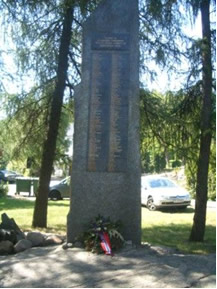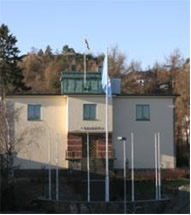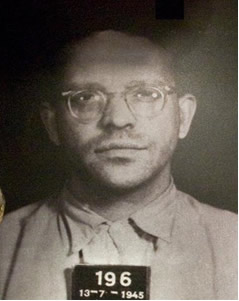



In his excellent book ”Arkivet”, Kristen Taraldsen writes that the orgy of violence at the former State Archives in Kristiansand belongs to the darkest chapter of the German occupation.
These dark chapters can only be told, as Taraldsen does, through the exploits of the men and women who, because of their endeavours to maintain a free and independent Norway, were incarcerated within its walls. During the 4 years from 1942 to 1945, over 3500 men and women spent more than 4 days in what became known as “The house of horrors” and “Tower of Torture”. Most of them suffered tough interrogation, over 400 were cruelly and systematically tortured, and 162 died in concentration camps or were executed.
 Today, a stone monument outside the building records the names of all these victims. The names are repeated on the walls of the stairway leading down to the original entrance.
Today, a stone monument outside the building records the names of all these victims. The names are repeated on the walls of the stairway leading down to the original entrance.
After the war, the building again housed the state archives but in 1997 a new location was opened in Oslo. It was decided that the empty Kristiansand building should be sold to the highest bidder but this sparked a spontaneous outcry: from war-veterans, historians, and community-minded citizens alike. An MP brought up the case in Parliament and the sales plan was dropped. In January 1998 interested individuals formed an action committee and shortly afterwards politicians approved their plans for turning “Arkivet” into a special museum.
 When the Stiftelsen Arkivet (Archive Foundation), moved into the building, the prison cells and torture chambers in the basement were restored to their wartime state. The events that took place in the basement are depicted with the help of full-sized reconstructions, exhibits, and mannequins. The aim is to preserve the Archive’s history, both as a reminder, and as a resource for active retelling. Every year approximately 8000 pupils visit Arkivet and schools are offered several programmes for inter-active participation. The basement is open to the public on Sundays from 1:00 to 3:00 pm and in July, every day except Saturday. Guided tours start at 1:30 pm.
When the Stiftelsen Arkivet (Archive Foundation), moved into the building, the prison cells and torture chambers in the basement were restored to their wartime state. The events that took place in the basement are depicted with the help of full-sized reconstructions, exhibits, and mannequins. The aim is to preserve the Archive’s history, both as a reminder, and as a resource for active retelling. Every year approximately 8000 pupils visit Arkivet and schools are offered several programmes for inter-active participation. The basement is open to the public on Sundays from 1:00 to 3:00 pm and in July, every day except Saturday. Guided tours start at 1:30 pm.
In addition to the museum, the building provides a common location for several central humanitarian and peace-building organizations including Red Cross, Save the Children, UJnited Nations Association, C.I.S.V., Neveragain.no Foundation, and Amnesty International.1
The chief Gestapo officers at “Arkivet” were:
SS-Hauptsturmsf?hrer Rudolf Kerner.
Born February 21, 1910 in Saarbr?cken.
Trained as shoemaker, worked in his mother’s shoe business from 1932 – 1936. He became an NSDAP member in 1935.
When his mother’s business was sold he joined the police force. In 1937 he began to study at the Institute of Criminal Technology in Berlin. In 1940, after two year in various positions he was promoted to Criminal Commissioner.
 On September 3 he arrived in Norway and became head of the Security Police (SIPO/SD)in Kristiansand. In January 1942 SIPO/SD took over Arkivet as headquarters with responsibility for Kristiansand and southern Norway. His direct superior was the Commander of Security Police in Stavanger.
On September 3 he arrived in Norway and became head of the Security Police (SIPO/SD)in Kristiansand. In January 1942 SIPO/SD took over Arkivet as headquarters with responsibility for Kristiansand and southern Norway. His direct superior was the Commander of Security Police in Stavanger.
But one of the most feared men was not in the SS: Norwegian State-policeman Ole Wehus.
He retained his position throughout the war and was sentenced to death by a Norwegian court in 1947. The death penalty was commuted to life imprisonment in 1948 but he was freed and returned to Germany in 1953.
SS-Lieutenant Wilhelm Schulz – Kerner’s deputy.
SS-Sturmscharf?hrer Hans Lipicki – Known as “the butcher.”
SS-Sturmscharf?hrer Friedric Wilhelm Meyer
SS-Hauptscharf?hrer Fredrich Alberg Lappe
SS-Hauptscharf?hrer Paul Glomb
SS-Untercharf?hrer Heinrich Willf?her
SS-Srurmscharf?hrer Hans Petersen
SS-Oberscharf?hrer Franz Gromann
1.Stiftelsen Arkivet Center for Historical Reflection and Peacebuilding – brochure in English.